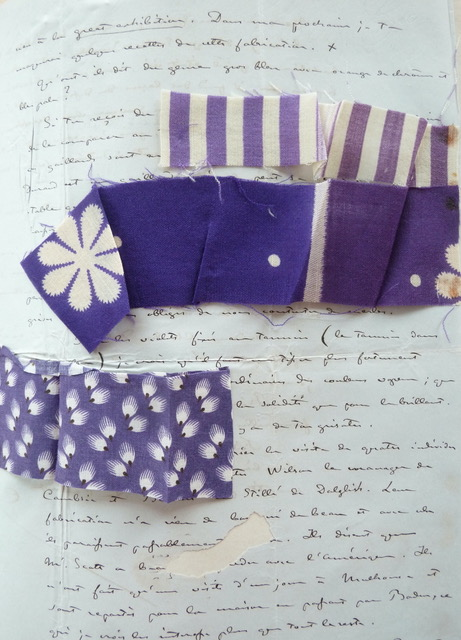
Fixing aniline violets around 1860: a European network
Colour Materiality
1861
In 1860 and 1861, Horace Koechlin (1839-1899), the eldest son of Camille Koechlin (1811-1890), worked in Bonhill near Glasgow, within the Dalmonach Print Works. Belonging to an important Alsatian family of chemists, Horace Koechlin had first been trained as a chemist at the School of Chemistry in Mulhouse (France). He then experienced as a colorist in calico printing with his father at Steinbach-Koechlin, one of the most famous textile manufactories in Mulhouse. Extremely well informed on British technical improvements and often travelling to Lancashire, Manchester and Glasgow, Camille Koechlin sent his son to the very firm where James Black and William Henry Perkin had improved the fastness of aniline violet. Between 1858 and 1862, Perkin and other chemists and dyers had two major problems with aniline violet: its lack of fastness and its poor yield. Part of the thirty or so British and French patents for synthetic reds and violets, which followed Perkin’s patent in 1857, dealt indeed with either issue.
Horace’s stay and work in Glasgow is documented by his father’s letters, in which technical data with samples attached to letters are discussed. This unpublished correspondence is kept in public archives in France, near Rouen (Darnétal, Archives départementales de Seine-Maritime, Fonds Koechlin, 60 J 7). Regarding aniline violets, Camille Koechlin particularly stresses the purity of aniline used to obtain purple, the process of preparing the tannin used to fix it whether the tannin is mixed with the dyestuff or not, the advantage of adding albumin to fuchsine whenever the fibers have been previously treated with tin, and the possibility of adding zinc to fuchsine to saturate its nuance. Different sellers of aniline or aniline purples appear in the letters, such as Poirier and Fayolle, and Camille keeps his son informed of the progress of the fuchsine trial between Jean Gerber-Keller and Renard Frères. Occasionally, Camille Keochlin anticipates their future participation in the 1862 International Exhibition to come in South Kensington, London, which he calls “Great Exhibition” as the 1851 venue. He also mentions chemists, colorists, fabric owners, travelling to Mulhouse and visiting the different Koechlin firms; he then asks his son whether he saw them in Bonhill. Reading this very detailed correspondence therefore allows us to follow, step by step, the different attempts made by scientists and practitioners during the colour turn to explore and domesticate the possibilities offered by the aniline dyes.
Finally, we learn by this correspondence that the Scottish associates would have liked Horace Koechlin to keep working at the Dalmonach Print Works. But as Camille Koechlin had foreshadowed to his son in May 1861: “The point is to come back from Scotland as a sovereign returned from a war of conquests.(…) the moment comes when those who know English work will be most sought after”. At the beginning of 1862, Horace comes back to France, hired as technical director by Cordier, in Rouen.
Bibliography
-
Alexandre, Alain and Croguennec, Michel, Histoires d’usines 180 ans de vie industrielle dans l’agglomération rouennaise, Nolléval, Éditions L’Écho des vagues, 2013.
-
Gril-Mariotte, Aziza, Les indiennes. La création des toiles imprimées, des Indes aux manufactures alsaciennes (XVIIIe-XIXe siècles). Suivi de l'édition du manuscrit écrit par Jean Ryhiner, à partir de 1766, Milan, Silvana Editoriale, 2022.
-
Hau, Michel, L’industrialisation de l’Alsace (1803-1939), imprimerie Louis-Jean, Gap, 1987.
-
Stoskopf, Nicolas, "Koechlin", in Cabanel, Patrick and Encrevé, André (ed.), Dictionnaire biographique des protestants français de 1787 à nos jours, Tome 3 : H-L, Paris, Les Editions de Paris, 2022, p. 456-490.
-
Travis, Anthony S., The Rainbow Makers : the origins of the synthetic dyestuffs industry in western Europe, Bethlehem, Lehigh University Press, 1993.